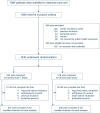Effect of the use of an endotracheal tube and stylet versus an endotracheal tube alone on first-attempt intubation success: a multicentre, randomised clinical trial in 999 patients
- PMID: 34032882
- PMCID: PMC8144872
- DOI: 10.1007/s00134-021-06417-y
Effect of the use of an endotracheal tube and stylet versus an endotracheal tube alone on first-attempt intubation success: a multicentre, randomised clinical trial in 999 patients
Abstract
Purpose: The effect of the routine use of a stylet during tracheal intubation on first-attempt intubation success is unclear. We hypothesised that the first-attempt intubation success rate would be higher with tracheal tube + stylet than with tracheal tube alone.
Methods: In this multicentre randomised controlled trial, conducted in 32 intensive care units, we randomly assigned patients to tracheal tube + stylet or tracheal tube alone (i.e. without stylet). The primary outcome was the proportion of patients with first-attempt intubation success. The secondary outcome was the proportion of patients with complications related to tracheal intubation. Serious adverse events, i.e., traumatic injuries related to tracheal intubation, were evaluated.
Results: A total of 999 patients were included in the modified intention-to-treat analysis: 501 (50%) to tracheal tube + stylet and 498 (50%) to tracheal tube alone. First-attempt intubation success occurred in 392 patients (78.2%) in the tracheal tube + stylet group and in 356 (71.5%) in the tracheal tube alone group (absolute risk difference, 6.7; 95%CI 1.4-12.1; relative risk, 1.10; 95%CI 1.02-1.18; P = 0.01). A total of 194 patients (38.7%) in the tracheal tube + stylet group had complications related to tracheal intubation, as compared with 200 patients (40.2%) in the tracheal tube alone group (absolute risk difference, - 1.5; 95%CI - 7.5 to 4.6; relative risk, 0.96; 95%CI 0.83-1.12; P = 0.64). The incidence of serious adverse events was 4.0% and 3.6%, respectively (absolute risk difference, 0.4; 95%CI, - 2.0 to 2.8; relative risk, 1.10; 95%CI 0.59-2.06. P = 0.76).
Conclusions: Among critically ill adults undergoing tracheal intubation, using a stylet improves first-attempt intubation success.
Keywords: Acute respiratory failure; Airway; Complications; Critical care; Intensive care unit; Intubation; Stylet.
Conflict of interest statement
SJ reports receiving consulting fees from Drager, Medtronic, Baxter, Fresenius-Xenios, and Fisher & Paykel. TR is a paid consultant of bioMerieux and Baxter. He has received grant support from bioMerieux, Baxter and Fresenius Medical Care and fees for lectures during industry symposia for bioMerieux, Baxter, Fresenius Medical Care, Bbraun and Nikkiso. VL reported being a member of a research group that has received grants from Alexion, Baxter, MSD, Gilead, Sanofi, Celgène. ADJ reports receiving consulting fees from Medtronic. No conflict of interests is reported for other authors.
Figures



Comment in
-
Use of stylet and airway management procedure in critically ill patients.Intensive Care Med. 2021 Dec;47(12):1497-1498. doi: 10.1007/s00134-021-06476-1. Epub 2021 Jul 10. Intensive Care Med. 2021. PMID: 34245314 No abstract available.
-
Intubation in intensive care unit: Is it time to update guidelines?Anaesth Crit Care Pain Med. 2021 Oct;40(5):100946. doi: 10.1016/j.accpm.2021.100946. Epub 2021 Aug 31. Anaesth Crit Care Pain Med. 2021. PMID: 34478873 No abstract available.
-
Use of stylet and airway management procedure in critically ill patients. Author's reply.Intensive Care Med. 2021 Dec;47(12):1499-1500. doi: 10.1007/s00134-021-06518-8. Epub 2021 Sep 14. Intensive Care Med. 2021. PMID: 34522982 No abstract available.
-
Securing the airway in critical care scenarios: questioning the fundamentals.Intensive Care Med. 2021 Dec;47(12):1501-1502. doi: 10.1007/s00134-021-06547-3. Epub 2021 Oct 5. Intensive Care Med. 2021. PMID: 34609550 No abstract available.
-
[Focus ventilation, oxygen therapy and weaning : Intensive medical care studies from 2020/2021].Anaesthesist. 2021 Nov;70(11):967-976. doi: 10.1007/s00101-021-00979-8. Epub 2021 Oct 6. Anaesthesist. 2021. PMID: 34613457 Free PMC article. German. No abstract available.
-
Securing the airway in critical care scenarios-questioning the fundamentals Author's reply.Intensive Care Med. 2021 Dec;47(12):1503-1504. doi: 10.1007/s00134-021-06552-6. Epub 2021 Nov 2. Intensive Care Med. 2021. PMID: 34727213 No abstract available.
References
-
- De Jong A, Molinari N, Terzi N, Mongardon N, Arnal JM, Guitton C, Allaouchiche B, Paugam-Burtz C, Constantin JM, Lefrant JY, Leone M, Papazian L, Asehnoune K, Maziers N, Azoulay E, Pradel G, Jung B, Jaber S. Early identification of patients at risk for difficult intubation in the intensive care unit: development and validation of the MACOCHA score in a multicenter cohort study. Am J Respir Crit Care Med. 2013;187:832–839. doi: 10.1164/rccm.201210-1851OC. - DOI - PubMed
-
- Cook TM, El-Boghdadly K, McGuire B, McNarry AF, Patel A, Higgs A. Consensus guidelines for managing the airway in patients with COVID-19: Guidelines from the Difficult Airway Society, the Association of Anaesthetists the Intensive Care Society, the Faculty of Intensive Care Medicine and the Royal College of Anaesthetists. Anaesthesia. 2020;75:785–799. doi: 10.1111/anae.15054. - DOI - PMC - PubMed
-
- Patwa A, Shah A, Garg R, Divatia JV, Kundra P, Doctor JR, Shetty SR, Ahmed SM, Das S, Myatra SN. All India difficult airway association (AIDAA) consensus guidelines for airway management in the operating room during the COVID-19 pandemic. Indian J Anaesth. 2020;64:S107–s115. doi: 10.4103/ija.IJA_498_20. - DOI - PMC - PubMed
-
- De Jong A, Molinari N, Pouzeratte Y, Verzilli D, Chanques G, Jung B, Futier E, Perrigault PF, Colson P, Capdevila X, Jaber S. Difficult intubation in obese patients: incidence, risk factors, and complications in the operating theatre and in intensive care units. Br J Anaesth. 2015;114:297–306. doi: 10.1093/bja/aeu373. - DOI - PubMed
-
- Russotto V, Myatra SN, Laffey JG, Tassistro E, Antolini L, Bauer P, Lascarrou JB, Szuldrzynski K, Camporota L, Pelosi P, Sorbello M, Higgs A, Greif R, Putensen C, Agvald-Öhman C, Chalkias A, Bokums K, Brewster D, Rossi E, Fumagalli R, Pesenti A, Foti G, Bellani G. Intubation practices and adverse peri-intubation events in critically ill patients from 29 countries. JAMA. 2021;325:1164–1172. doi: 10.1001/jama.2021.1727. - DOI - PMC - PubMed
Publication types
MeSH terms
LinkOut - more resources
Full Text Sources
Other Literature Sources
Medical

